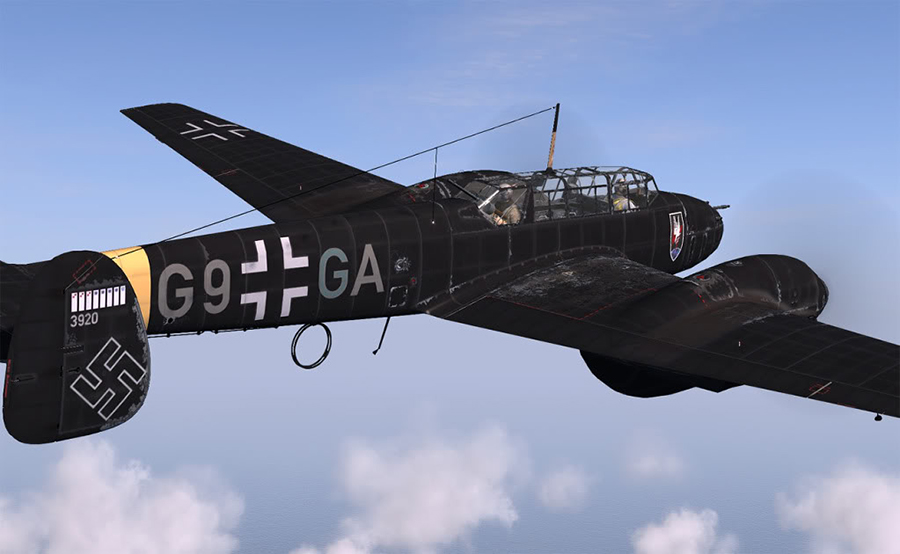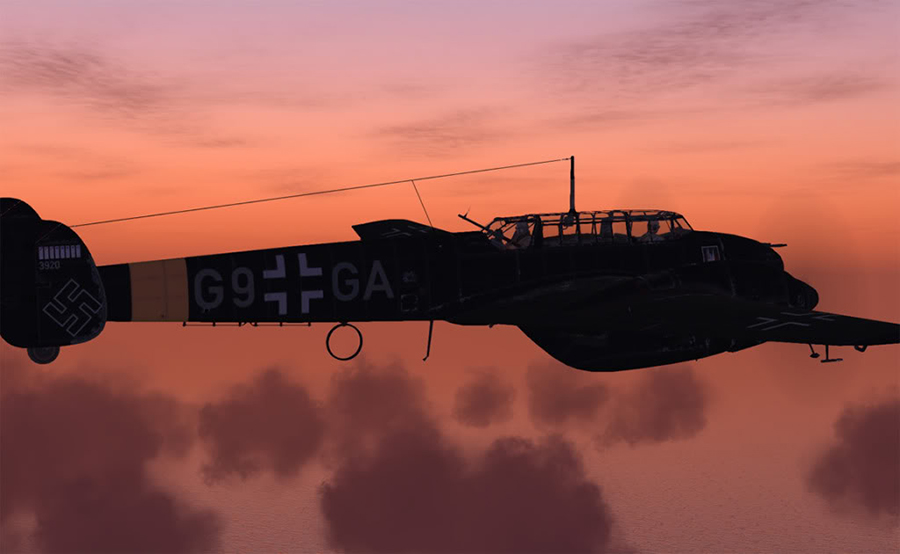Return to Bf-110
Bf 110 G9+GA

Increasingly frustrated by night attacks from RAF
bombers on the German airfield at Aalborg in northern Denmark, Hauptmann
Wolfgang Falck, who was stationed there, wrote a comprehensive report evaluating
the possibility of combating those raids, arguing that his Gruppe of Bf
110s would be better suited as night fighters. With the British directing their
attacks against Cologne and the industrialized Ruhr, his recommendations were
approved and two months later, in June 1940, the first night-fighter unit was
established,
Nachtjagdgeschwader 1, and Falck promoted to Kommodore of its first
Gruppe, I./NJG 1. The
Englandblitz badge so prominently displayed in this photograph of the plane
on a snowy runway in Düsseldorf derived from his family coat of arms, falke
meaning "falcon" in German.

Coded G9+GA, it belonged to Stab NJG 1 and was the first to be painted overall in
a permanent black nitro-cellulose lacquer, the smooth surface adding several
miles per hour in speed but also imparting a light sheen to the aircraft. The
green letter "G" was a carryover from Falck's earlier combat flying and against
regulation.
As Kommodore of NJG 1, it properly should be "A," Falck explaining that
"G" was the seventh letter of the alphabet and seven was his lucky number.
Later, he would fly in a plane coded G9+AA but only in a non-operational role
(the "A" in the blue of the Geschwaderstab).

There is some uncertainty as to whether Falck
tallied seven victories or eight, depending upon whether a RAF kill was
confirmed. But Weal does show eight bars in a photograph taken at the time,
and this is how the plane has been depicted: three won in Poland, four in
Britain, and one in Denmark. In October 1940, Falck was awarded the Knight's
Cross
,
as much in recognition of his administrative and
organizational abilities as his victories in the air—all
of which, ironically, were won flying in the daytime.
The coding system
used to identify German aircraft (other than day fighters such as the Me 109) consisted of two
sets of
characters, one in front of the national marking, the Balkenkreuz
("bar cross"), and another after it. The first
alphanumeric pair (seemingly assigned at random) was the identification code of the Geschwader
(Group in British parlance), the main operational unit of the Luftwaffe. It was
comprised of three, and later four or five Gruppen (Wings), each
designated by a Roman numeral preceding the abbreviated name of the
Geschwader to which it belonged. The Gruppe, in turn, usually
comprised three (or four) Staffeln (Squadrons) that were designated by
Arabic numerals. Finally, each Geschwader and Gruppe were
commanded by a Stab or Staff unit.
The first letter after
the cross identified the individual aircraft in the Staffel and
usually was painted or outlined in its identifying color. The last letter
signified the Staffel (or Stab) itself. The Geschwader Stab,
for example, was designated by "A" and the individual aircraft letter colored
blue. The letters B, C, D, F, and G designated Gruppen Stab I-V
respectively, with the individual aircraft letter in green. Letters H through
Z (with the omission of I and J, O and Q, which might be confused with one
another) identified Staffeln 1-15, the colors of which rotated through
a sequence of white, red, and yellow, 1 Staffel being white; 2
Staffel, red; and 3 Staffel, yellow—which
then repeated itself.
This at least was the
nominal notation,
which changed as the war progressed. Eventually, the number of Staffeln
increased from 15 to 20, and the omitted letters Q, J, O, E, and I, respectively,
utilized to identify them.
References: German Night Fighter Aces of World War 2 (1998) by Jerry Scutts
(pp. 14, 34, 92); Messerschmitt's Twin-Engined
Fighters from 1939 to 1945 (2009) by Dominique Breffort
and André Jouineau;
Nachtjäger: Luftwaffe Night Fighter Units, 1939-1943, Vol. I (2005) by
David P. Williams (pp. 4-5, 21-25);
Messerschmitt Bf 110 Zerstörer Aces of World War 2
(1999) by John Weal (p. 24); Messerschmitt's Twin-Engined
Fighters from 1939 to 1945 (2009) by Dominique Breffort
and André Jouineau (p. 18);
Luftwaffe Camouflage and Markings 1935-1945: Photo Archive 1 (2007)
by K. A. Merrick, Eddie J. Creek, and Brett Green
(p. 43); Luftwaffe Codes, Markings & Units 1939-1945 (1995) by Barry C. Rosch
(p. 11).
Return to Top of Page



